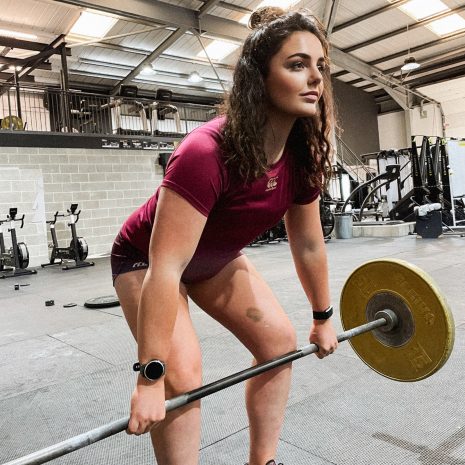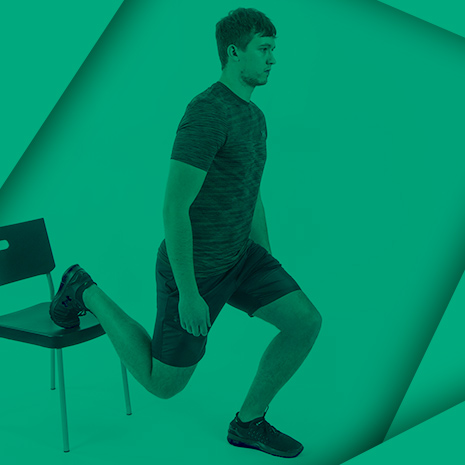We’ve teamed up with esteemed Chartered Physiotherapist, Neil Aitken to give you high-quality information on the most common rugby injuries and how to best recover from them. If there’s a particular injury you’d like us to cover with Neil’s help, get in touch with us on social media (Facebook | Twitter).
Quick links
- What happens when you tear your Achilles tendon?
- How do you know if you have a torn Achilles tendon?
- Can a torn Achilles tendon heal on its own?
- What happens after surgery?
- How long does it take to recover from a torn Achilles injury?
- How long does it take to recover from a strained Achilles?
- What are the best exercises and stretches for the Achilles tendon?
What happens when you tear your Achilles tendon?
Like any ligament or tendon injury you may tear some or all of the fibres. It usually requires a high force to do this. The body has a very good healing system so the tendon will heal, but it requires time and the correct management. As it heals it is important to expose the tendon to gradually increasing forces. This helps the new tendon tissue to be strong and withstand the forces that it will have to tolerate in sport as well as everyday life.
How do you know if you have a torn Achilles tendon?
If it is a partial tear you will have felt a sharp pain at the Achilles (where your calf muscle meets your heal bone). It will be sore to walk but you will usually be able to weight bear on that foot. There may also be swelling present.

If it is a full tear you may have heard a pop/snap at the time of the injury and also felt like someone had kicked you in the calf/back of the ankle. There will have been a sharp pain, but this may then change to a dull ache or even no pain at all. It will be very difficult to walk on that foot and you will struggle to go up stairs. A squeeze test may be performed on your calf whereby you lie on your front with your foot off the edge of the bed. When they squeeze your calf your foot should move. If you have ruptured your Achilles it will stay still.
Can a torn Achilles tendon heal on its own?
It can, but it still requires treatment. Your lower leg would be placed in a cast which would be removed and re-applied every 2-3 weeks so that the angle of your ankle can be changed. You would usually have this on for 6-8 weeks. Once the cast has been removed you would start a graded rehabilitation program. It could be up to a year before you can resume full activity. This type of treatment is usually only used for less active people so if you are a rugby player it is more likely that they will choose to operate. Surgically repaired Achilles tendons have a lower chance of re-rupturing.

What happens after surgery?
The ruptured tendon can be repaired surgically and your lower leg will then be placed in a cast or brace for 4-6 weeks. Once removed you will start a graded rehabilitation program. It is critical to work hard at these exercises to lower your chance of re-rupturing the tendon at a later date. Higher level activity can generally begin at roughly 4 months but it may take up to a year for an athlete to return to the level of activity they were at prior to the injury. It is a long process but you should fully recover and be able to take part in all forms of sport again.
How long does it take to recover from a torn Achilles injury?
If it is partially torn it may take 3-6 months before you are back to full activity. After a full rupture you might be able to be more active at the 4 month mark but it can take up to a full year before you are able to fully partake in sport.
How long does it take to recover from a strained Achilles?
If you have been told you have a strained Achilles it is likely you have only torn some of the tendon fibres. As above this may take up to 3-6 months to fully resolve.
What are the best exercises and stretches for the Achilles tendon/calf?
(If you have partially or fully torn your Achilles always follow the guidelines set out by your physiotherapist. The following is only an example of the types of exercises you may do)
- When stretching your calf it is important to do two different stretches as you need to stretch both your soleus and gastrocnemius muscles. The soleus stretch involves a bent knee whereas with the gastrocnemius stretch you keep your knee straight.
- Heel raises, also called calf raises, are important to build the strength and endurance of your calf. As a general guide a regular member of the public should be able to do 30 heel raises on one leg, a fit person should manage 40 and an athlete should be able to do 60. This should be a slow and controlled movement, on one leg, keeping your knee straight and pushing your heel up off the ground as high as you can for every repetition.
- Squats are good because they require good ankle mobility.
- Deadlifts strengthen the posterior chain so will involve the calf.
- More dynamic exercises like lunges, kettlebell swings, hopping, skipping, bounding, running and jumping are used in later stages of rehab.
About the author
Neil Aitken is a Chartered Physiotherapist with a private clinic in Edinburgh. He has previous experience as a senior physiotherapist in the NHS and provided physio for one of the top amateur rugby teams in Scotland. He is highly evidence-based having completed a Post Grad in Musculoskeletal Physiotherapy gaining membership to the MACP, one of the most highly respected qualifications within physiotherapy.
Website: http://www.neilaitkenphysio.co.uk/
Facebook: https://www.facebook.com/neilaitkenphysio/
Twitter: @aitkenphysio

Disclaimer: This article is intended to serve as a guide for general information only. Injuries should be assessed by a qualified specialist such as a physiotherapist or doctor. When you sustain an injury, there are always complicating factors that may need to be assessed and addressed by a professional.




Comments